Everything coming together
January 13, 2009 | dlpmagazine.com Tech Smart Everything coming together A trend of convergence and connectivity is the story behind the flashy new gadgets on display at the 2010 Intern
January 13, 2009 | dlpmagazine.com
Tech Smart
Everything coming together
A trend of convergence and connectivity is the story behind the flashy new gadgets on display at the 2010 International Consumer Electronics Show.
by Noah Levine
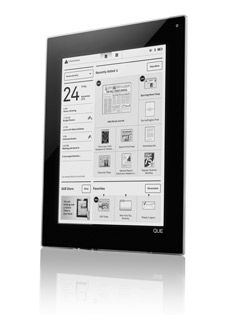
The Que eReader is stylish and slim with lots of newspaper and magazine content.
Regardless of what you are looking at on the CES show floor, there’s always another screen bringing a high definition glint to the periphery. The surplus of fresh sights and sounds is enough to make eyes glaze and the mind blur, but after stepping away from the electronic overload, the meaning behind all the new gear takes a clear shape.
Every year this gathering of high tech companies in Las Vegas at the world’s largest consumer electronics tradeshow seems to launch one major product and this year 3D TV sets were the much hyped item. Every major (and many minor) maker of screens offered up their versions of this new way for people to experience their visual entertainment, and for the most part it works as advertised.
Pictures come to life and escape from the screen, making animated movies look spectacular, live sports even more lively and video games unbelievably immersive. Sure some scenic images have a cutout feel, and the big drawback remains the need to wear special glasses to see the unleashed images, but the technology is ready for market and over several years it is likely to be improved (hopefully to the point where glasses are no longer needed) and it could become the new norm.
But 3D TV is really a big picture idea (sorry about the pun) just starting to touch down. The real stars of the 2010 CES are technologies that are not only developed enough to be ready for the commercial market, but technologies that consumers are ready to put to use right away. These game changers come packaged as little touches that add a lot to things we’re already comfortable with, new developments that align existing systems so they can work symbiotically, and tiny devices that make portability convenient.
Some are in stores already, others are coming later this year and a few are still in the dream stage. Throughout the year Tech Smart will feature in-depth profiles on some of these products, but here is a quick overview of the new ideas, concepts and products that could impact your business and life in the future.
Computers
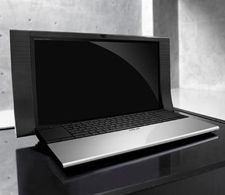
The NX90 from Asus brings a new level of sophistication to the laptop market.
When it comes to computers it’s a good idea to add “smaller” to the “better, faster, stronger” Bionic Man trio of improvements. Sure a few desktops were on display and every company touted concepts for high-powered tablet offerings, but at the 2010 CES the most impressive machines ready for the shelves came in the laptop and netbook categories. The most beautiful of the machines came from Asus with the NX90 laptop designed by Bang & Olufsen and featuring robust built-in speakers and a gorgeous screen. LG also showed up with a nice entry in the laptop category. It’s X120 features a quick and responsive dual processor and a price point less than $200.
Plenty of computer peripherals also stood out. Monitors continue to get thinner with sharper pictures, and it’s easier than ever to connect multiple screens to the same computer. It’s a good idea to get used to touching those screens, as touchscreen interfaces were available from a number of companies, including MSI who showed off the Wind Top AE2010 running Windows 7 with no mouse or physical keyboard necessary.
When it comes to input devices, Wacom’s line of touchscreen and pen-based tablets set the standard for onscreen design. The Cintiq interactive display allows the user to use the pen directly on the screen, making the interface even more user-friendly. Available with or without a pen, the multi-touch capable Bamboo tablets make maneuvering items on screen simple and intuitive, and could make the mouse obsolete.
CONTINUED ON NEXT PAGE
{NEW_PAGE}
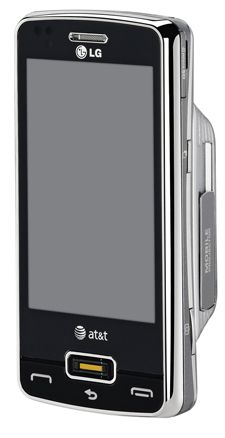
The LG from Expo with attached projector.
Smartphones
The standard bearer in this category-which might be better called pocket computers-remains Apple’s iPhone, but that’s not to say there are not a number of worthy competitors hitting the market. Just prior to CES Google launched its HTC-built Nexus One promising great integration with the Web giant’s cloud software and online utilities.
Also making impressive showings among the recent releases was Motorola’s Droid. Running on Google’s Android platform and boasting a buttery smooth touchscreen interface, the Droid showed itself to be a powerful and adaptive device that could be an asset for business, fun or both.
LG also stepped into the smartphone market with the business-focused Expo. The touchscreen interface on this unit is easy to use, and with a crisp and bright snap-on projector, it’s ready to be not just a communications center, but also a full on traveling presentation system.
eReaders
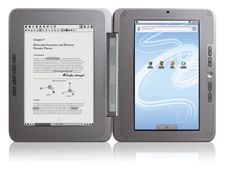
The eDGe from enTourage pairs its eReader with a touchscreen netbook.
Amazon’s Kindle and the nook from Barnes & Noble will now have plenty of company on the shelves as just about every booth at CES seemed to have a device aimed at this fast growing category of consumer electronics. Sony expanded its line of readers, and many other manufacturers offered up similar devices with crisp e-Ink displays and links to online booksellers.
Standing out from the crowd in this arena was the twin-screened eDGe from enTourage and the sleek Que. The eDGe is the most booklike of the eReaders with the expected screen placed side-by-side with a full-color touchscreen useful for Web surfing, media playback and content management. The device basically combines a fully functional netbook and a robust eReader into one small package.
When it comes to small (in profile at least) no eReader could match the stylish Que. Aimed at business readers, this thin tablet is designed to make reading newspapers and magazines easy and portable while adding in Outlook calendar synching and Office document access.
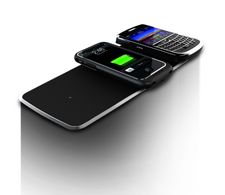
The PowerMat charges devices without a tangle of cords.
Business tools
Whether looking to enhance the technology in the office, or to take your office with you, the 2010 CES had plenty to offer. Printers keep getting better, and portable harddrive storage has never been easier to use. One touch portable back up systems were everywhere, and Iomega was showing off its new eGo drives with a v.Clone system that backs up not only data, but the entire operating system, making the computer being backed up accessible on any system the drive gets connected to.
If a mobile office is key, PlanOn’s DocuPen could be a valuable asset. The Bluetooth enabled scanner is (as the name implies) the size of a pen, and it makes capturing printed pages easy and fast. If presentations on the go are an important part of what you do, carrying a projector has never been easier. The MPro series from 3M are nice pocket-sized options for small groups. However, none of the mini projectors could compete with the high power and sharp pictures coming from Optoma’s line of Pico projectors. With easy connectivity to all range of devices and direct on-projector storage via SD card, one of these can be all that’s needed to take a show on the road.
When it comes to keeping mobile devices properly juiced up, it’s never been easier to get away from using cords. Among the wireless charging solutions, PowerMat offered the most impressive with a stylish line of systems to charge everything from smartphones to laptops by replacing the stock battery cover’s with the company’s special covers and then setting the device on the mat itself. A pleasant sound alerts that charging has begun and the days of fumbling with plugs and wires are over.
CONTINUED ON NEXT PAGE
{NEW_PAGE}
Connectivity
All of these systems are getting smaller and making business and life easier and more portable, but a big trend at CES 2010 was making all of these systems work together. The TV manufacturers are adding wi-fi directly into their latest HD sets to make it possible to play online media on the big screen without any additional device. Many are also building Skype directly into the units, making big screen video-conferencing more convenient than ever.
Taking data with you no longer means carrying around hard drives. Whether setting up a local server to be accessible to all computers on an office wi-fi network, or having a network drive tied into the Web so its contents can be located online from anywhere, drive makers like Iomega and D-Link have a solution. If sharing media files between computers and TVs, or simply playing online content such as training videos on the big screen is what you’re after, D-Link’s new Boxee Box or Pebble can get the job done.
The future
Most of the technology on display at the 2010 CES is hitting the stores now or slated for shipment at some point later this year, but that doesn’t mean companies weren’t there to showcase some of their dreams as well. 3M displayed a fully functioning multi-touch screen that allowed 10 simultaneous touchpoints at once. Collaborative interactivity on a system like that could have lots of possibilities from design teams working together to new horizons in video game control.
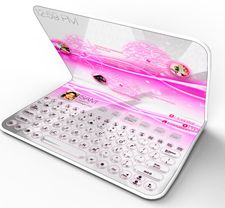
The Waveface Light flexible laptop is one piece of Asus' Waveface concept of flexible computing and data synchronization.
The most forward thinking product on display was the Waveface system Asus is cooking up. Designed to seamlessly manage data for multiple mobile users, the system mixed a large touchscreen wall unit, a slim laptop with a flexible touchscreen and a bendable smartphone designed to be worn on the wrist into one system. Each of the items gathers data from the world around it and synchs it when any device is near enough to the others. It’s designed to seamlessly integrate digital data into all aspects of work or life, and while no release date is on the horizon, the technology and concept proved stylish and impressive.
The world of electronics always seems to be accelerating with new and more powerful options always on the way. A massive show like the 2010 CES is a chance to take stock of where the cutting edge sits at the current moment, but it doesn’t mean everyone needs to rush to that edge. The new 3D televisions are that impressive cutting edge, but they don’t seem fully ready or practical today. The key to following technology is to stay tuned into where the edge is sitting, and to know wherever that is, it will be there for you when you’re ready to ad something new or upgrade what you have.
Noah Levine writes the monthly Tech Smart column on consumer electronics for Dental Lab Products. Contact him at nlevine@advanstar.com.
ACTIVA BioACTIVE Bulk Flow Marks Pulpdent’s First Major Product Release in 4 Years
December 12th 2024Next-generation bulk-fill dental restorative raises the standard of care for bulk-fill procedures by providing natural remineralization support, while also overcoming current bulk-fill limitations.